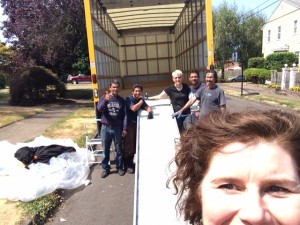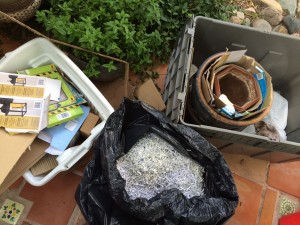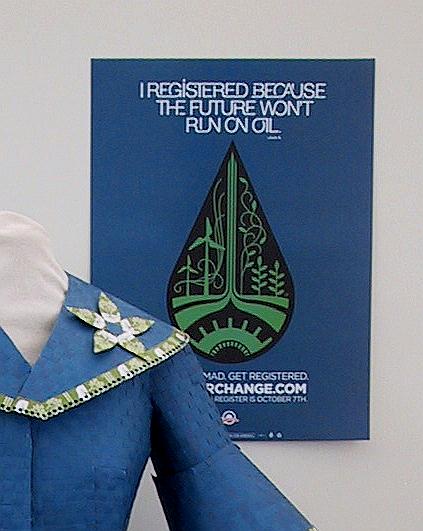Recycle Runway Blog
Moving and Sustainability Part 2

Celebrating the empty moving truck.
Last week I posted about my move to Portland, Oregon. My spouse Nicole, who is helping me with my blog-posts and social media campaigns, continues the theme diving deeper into the relationship between moving, sustainability, and nomadic cultures.
If you Google the word “nomad” lots of things come up right away: urban nomad, modern nomad, how to live a nomadic lifestyle, even a portable espresso machine. There is a great deal of idealistic notions and dreaminess about what it means to be a nomad like, not being tied down, seeing lots of new things or exotic places, being able to do your own thing, and not having to abide by rules. And in our western world of hyper-individualism, I also wonder how much of this dreaminess is caused by our dysfunctions such as, fearing intimacy, wanting to escape, and needing to be unique and therefore apart from others.
As Nancy and I moved to another state and I was surrounded by gobs and gobs of things, too much stuff, items I couldn’t part with, I wondered, “…am I really a hip, slick, and cool, modern, urban nomad?” I really wanted to identify with all that I imbue nomadism with but somehow I just wasn’t sure if that fit.
As I begin to pull up articles on pastoral nomadism (which is only one of the three types of nomadic lifestyles that include hunting & gathering communities and nomadic trades people such as gypsies) I realized that my imagination has created a very different reality from the one that exists. Pastoral nomads are tied to the land through the animals that they raise and herd. They carry a deep and ancient knowledge of the seasons, local sustainability, and animal husbandry handed down through their ancestors and communities. Their movement is based on having enough food and appropriate weather conditions for their animals to survive and the ability to know when and where to move on to in order not to overgraze, or kill off, this fertile ground which they will return to next season. They are extraordinarily intimate with every plant and water source along their journey because this is how they have always lived and it is part of a routine.

Rubari Nomads of India, photo by Nevil Zaveri
Pastoral nomads are not only tied to the land, but to the settled peoples that they encounter along their path. Since their mainstay is animal husbandry, their main sources of food are the byproducts of raising animals such as milk, cheese, animal skins, and in some cases animal blood. But humans must have plant material in their diets to be healthy and so nomads trade their wares along their route for the necessary grains and vegetables which settled, agrarian cultures grow. True, though these relationships may be ancient, nomads can still be taken advantage of or seen as outsiders and treated disrespectfully, however each culture, nomad and agrarian, benefits from them.
Nomadic life is challenging. Modern governments have taken over nomadic land and tried to force settlement onto them by establishing rules about grazing or movement making living in their customary way even more difficult to uphold.
Common nomadic life is one constantly exposed to the elements such as extreme heat, cold, or wind. Nomads often have adapted their lives to places of high altitude or extreme weather such as the Tibetan plateau or the deserts of the Middle East. Since their lives consist of traveling from one location to another, following good seasons or weather patterns, they usually live in some form of tent. Tent material can consist of wood, woven grasses, sheep and yak wool, or animal skins. Though the dwellings themselves are generally water and wind proof and the structures are adapted to keep in heat or cool depending on the season, the travel is arduous even if fulfilling.
Finally, to accommodate their transient lifestyle, their possessions are kept to essentials – in other words, they travel lightly. Everything is made to be movable, to be packed and hauled to the next stop, in their cyclical journey.
My vision comes slowly back to the very large storage space we rented, a twenty by twenty room filled from floor to ceiling with the possessions of two people, mine and Nancy’s, knowing that we also have a garage filled with more boxes and furniture, and I wonder again if I can really call myself a nomad?
Certainly, we did not traveling lightly, in fact, we traveled with what we can afford to travel with which translates our capability from an efficiency form into a monetary form. Our migration was not tied to a cyclical routine though our choice was motivated by sustainability since we hoped to not burden the New Mexico watershed further. But how sustainable is the modern notion of moving?

Reused packing materials, not one broken pot!
The average move in the Western world is pretty wasteful, where items are disposable and new things can be purchased easily. Here are some of the things we did to keep our move as environmentally friendly as possible. First, we used as many recyclable moving materials as possible. After talking to several local businesses, we found a furniture store that allowed us to take used packing material for our own use. We actually ended up creating a relationship where they called us about newly acquired materials after receiving a shipment of furniture! We also happened to have a great deal of personal documents in our recycle pile that had accumulated over the years. After shredding, we used this material to help protect packed items.
Of the items that we were able to part with, we used a number of reuse sources including: Freecycle, Restore, and local thrift stores to get rid of what we could not sell in our garage sale. We also took several trips to recycling centers with non-usable plastics, metals, and paper. Did you know that Goodwill will take any cloth material no matter the condition as it can have value as a rag too? We ended our process by having a “free” pile by the curb for our last minute unwanted items.
Our attempts to move sustainably continued after unpacking at our new location where we passed our packing materials on via FreeCycle to someone moving to California.
But had we ever gotten intimate with the seasons, the land, the flora and fauna of New Mexico? After more than twenty years of living in this beautiful land, we both felt it in our blood, the broad skies, the faint plateaus on horizons far away, the brown dirt hills patched with pinõn and juniper, the roadside altars of white crosses and flowers commemorating the dead, the coyote howling in the dead of night, the chili infused corn, pork, beans and posole. Perhaps we were intimate with the culture and essence of New Mexico, but could we have survived the land and known where to travel for the best grazing seasons for our herds? Not likely.
The migration of humans throughout the planet started in Africa with our ancient ancestors – it was how our planet was populated. People have moved throughout history to get to the land of milk and honey, to access more resources, to find a better way of life or a better agricultural environment. I find it doubtful that people will ever remain stationary for long. It seems like for every person that does not go beyond their home boundaries, there is one that will gladly roam. And, though we can do our part to make our moving footprint more green and less disposable, can we really compare ourselves with nomads in any way other than the yearning to be free?
 Nicole Morris-Judd is studying sustainability with a concentration on community resiliency at Goddard College. She and Nancy collaborated on an installation called Consumption: an exhibition exploring waste through New Mexico Arts in 2012.
Nicole Morris-Judd is studying sustainability with a concentration on community resiliency at Goddard College. She and Nancy collaborated on an installation called Consumption: an exhibition exploring waste through New Mexico Arts in 2012.








































